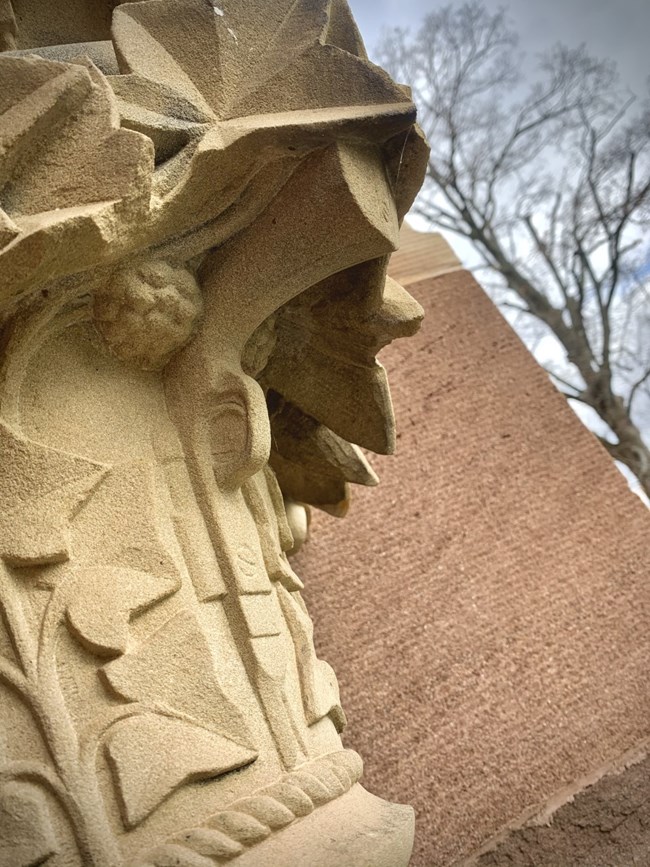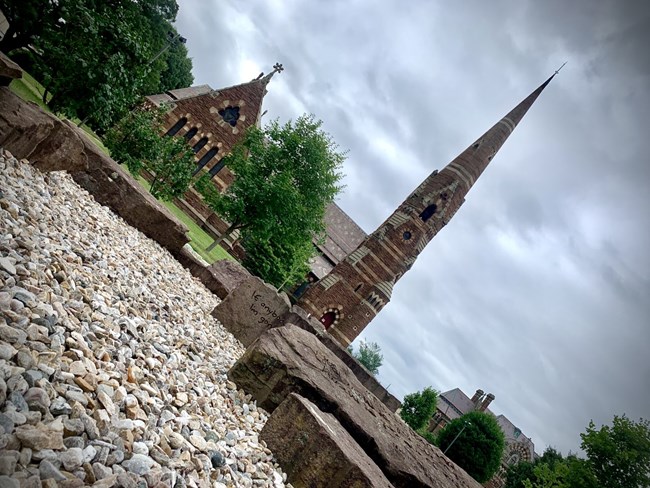|
The Church of the Good Shepherd is a functioning place of worship. Please note that while the grounds are open to the public, the building is not. Tours can be requesting by contacting the Church of the Good Shepherd.
Check out a 3D Tour of the interior of the Church of the Good Shepherd!
Elizabeth and Samuel Colt met in 1851, in Rhode Island, and on June 5th of 1856 they married. Despite the 12-year age gap, they were a match. Samuel with his inventive, driven personality was equally matched by Elizabeth who was described as being sweet, gentle, and gracious. After only six years of marriage Samuel Colt passed on January 10, 1862 leaving Elizabeth, who was pregnant, to care for two infants (one which would die 10 days later) and in charge of the Colt Armory. Elizabeth was heartbroken at the loss of her husband and children. But through all of the loss Elizabeth faced in life, she remained optimistic and dedicated to her life’s work. In coping with her loss, she would create lasting contributions to society. 
Photo Credit: NPS/Nick Caito Amongst trees near downtown Hartford and the Colt Armory complex rises the steeple of the Church of the Good Shepherd, commissioned by Elizabeth in memory of her husband and of their three children who passed in early childhood and infancy. Since 1859 a parish had existed in the South Meadows, but they didn’t have a permanent place of worship. In building a church, Elizabeth was able to help the community while remembering her family and husband. Initial plans for the Church, aptly named The Church of the Holy Innocents, were drawn by Frederick C. Withers. Elizabeth, dissatisfied with those plans, accepted plans drawn up by Edward Tuckerman Potter, a prominent architect who designed the Mark Twain House and would later design the Caldwell Hart Colt Memorial Parish House. The cornerstone of the church was laid in September of 1867 and two years later, on January 28th, 1869, the church was consecrated with an estimated cost around $150,000. 
Photo Credit: NPS/Dani Beekman Built in the Gothic Revival Style, the church served as a reminder to Elizabeth and all who entered that life was full of setbacks and challenges. At the time of its building, this style was starting to fade out of fashion and it was more common to have lighter and more open styled buildings. This style is ‘heavier’ and more substantial than the typical gothic style, meaning that it allowed for darker spaces and shadows within the church. The bright, vibrant stained-glass windows stand out in contrast, reminding those that while there is darkness in life, there is also hope and light. The church encompassed Elizabeth and the life she lived, one full of loss but yet full of hope and light. Out of all the exterior entrances the “Armorer's Porch” attracts the most attention due to its unique stonework surrounding the archway; different parts of the Colt Revolver, such as cylinders, triggers, hammers and pistol handles are carved into the stone around the entrance. These embellishments would have been clearly recognized by the armory employees, but they were included in decorative artwork that maintained the sanctity of the church. 
Photo Credit:NPS/Dani Beekman Light filters into the Church through the numerous stained-glass windows. Many of the windows are dedicated to significant persons in Elizabeth’s life, including her sister Hetty, her brother Richard, her son Caldwell and of course, Samuel. At the back of the church, is a pair of stained-glass windows designed and dedicated to Samuel and their children who passed. The windows contain biblical symbolism as well as the Colt family crest and motto at the bottom, ensuring that visitors to the church understand exactly why, and for whom, it was built. Another striking feature is the marble baptismal font depicting cherub-like children on a pedestal supporting a large shell basin in their arms for baptisms. This piece, commissioned for Elizabeth by her sister, Hetty, was dedicated to the three Colt children who passed away in early childhood and infancy. Elizabeth paid close attention to detail and everything was designed with a purpose. The symbolism within the church is endless from the stonework to the quotes selected to the stained-glass windows. Elizabeth remained a dedicated member of the church until her passing. 
Photo Credit: NPS/Dani Beekman On the grounds, just to the North of the church a Peace Pole stands amongst a white azalea bush. In Arabic, English, Spanish and Swahili, each language representing the racial and ethnic heritages of the congregation, the pole reads “May Peace Prevail on Earth.” The pole, placed during Reverends Dana Campbell’s term, expresses a shared prayer for peace in the Middle East and reminds everyone to think, speak, and act in peace. “How much better such a monument that the costly piles often erected over the tombs of the once wealthy dead, whose only use is to point out the spot where lies a little human dust. The latter speaks of only death. The former speaks of a better and enduring life beyond the grave.” Scientific American, July 24th, 1869
From its very conception, the Church of the Good Shepherd was meant to represent remembrance. These memorials complement this theme and help the Church stay relevant in its purpose through modern times. In 1975, the Church was added to the National Register of Historic Places and in 2008 it became a contributing building of the Coltsville Historic District, which is a National Historic Landmark District. In 2014, the United States Congress authorized creation of Coltsville National Historical Park. 
Photo Credit: NPS/Dani Beekman |
Last updated: January 2, 2022
